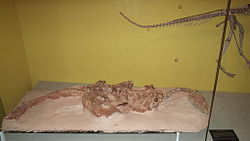グアイバサウルス
グアイバサウルス(Guaibasaurus)は後期三畳紀に生息していた恐竜の一つ。体長約1.5 m。ブラジルのリオグランデ・ド・スル州で発見された[1]。
| グアイバサウルス | ||||||||||||||||||||||||||||||||||||
|---|---|---|---|---|---|---|---|---|---|---|---|---|---|---|---|---|---|---|---|---|---|---|---|---|---|---|---|---|---|---|---|---|---|---|---|---|
 骨格 (UFRGS PV0725T) 。頸、頭部はヘレラサウルスに基づいた推定
| ||||||||||||||||||||||||||||||||||||
| 分類 | ||||||||||||||||||||||||||||||||||||
| ||||||||||||||||||||||||||||||||||||
| 学名 | ||||||||||||||||||||||||||||||||||||
| Guaibasaurus Bonaparte et al., 1999 | ||||||||||||||||||||||||||||||||||||
| 種 | ||||||||||||||||||||||||||||||||||||
|
発見
編集最初の化石は1999年、José F. Bonaparte・Jorge Ferigolo・Ana Maria Ribeiroによって命名された。属名は、"Prό-Guaíba Project"によってグアイバ川の近くから発掘されたことに由来する[2]。
Paleorrotaジオパークの2箇所の発掘場から、4個体の化石が発見されている[1]。
- "Sesmaria do Pinhal 2" - 基産地。カンデラーリア (リオグランデ・ド・スル州)の近くで、種小名もこの町に由来する[2]。
- "Linha São Luiz" locality near the town of Faxinal do Soturno
- UFRGS PV0725T - 前肢が1本ないが、ほぼ完全な体部骨格。
- MCN PV 10112 - クリーニングは行われていないが、手の一部を含む標本。
全標本はCaturrita層 (Rosário do Sul Group, パラナ堆積盆) の下部、またはSanta Maria 2 Sequenceの最上部から発見されており、これらの層は三畳紀後期のノリアン階前期 (216.5-212百万年前) のものと推定されている[1][3]。
UFRGS PV0725Tは、後肢を体の下に抱き込み、前肢を横に曲げた姿勢で保存されている。頸部は失われているが、基部の脊椎骨の角度からすると、頭部は体の左側に曲げられていたものと考えられる。この姿勢は休息時の鳥類に似ており、恐竜化石では、進歩的なマニラプトル形類のみから知られているものである。この姿勢は体温を保つためのものであると考えられる[4]。
系統
編集1999年の記載時点で、本種は獣脚類の基底あたりに位置付けられ、単独でグアイバサウルス科とされていた。Bonaparte et.al.(2007)によると、別のブラジル産恐竜サトゥルナリアは本種に似ており、本種とともにグアイバサウルス科として竜盤類の基底に位置づけられる。
Bonaparteは、この科は獣脚類に近縁であるとする見解を示している[5]が、現在では基底的な竜脚形類とする研究が多い[6][7][8][9][10]。 系統解析では、グアイバサウルス自体は基底的な獣脚類であるとする研究もある[1]。
脚注
編集- ^ a b c d Max C. Langer, Jonathas S. Bittencourt and Cesar L. Schultz (2011). “A reassessment of the basal dinosaur Guaibasaurus candelariensis, from the Late Triassic Caturrita Formation of south Brazil”. Earth and Environmental Science Transactions of the Royal Society of Edinburgh 101 (3-4): 301–332. doi:10.1017/S175569101102007X.
- ^ a b José F. Bonaparte, Jorge Ferigolo and Ana Maria Ribeiro (1999). “A new early Late Triassic saurischian dinosaur from Rio Grande do Sol state, Brazil”. Proceedings of the Second Gondwanan Dinosaur Symposium, National Science Museum Monographs 15: 89–109.
- ^ Marina B. Soares, Cesar L. Schultz and Bruno L. D. Horn (2011). “New information on Riograndia guaibensis Bonaparte, Ferigolo & Ribeiro, 2001 (Eucynodontia, Tritheledontidae) from the Late Triassic of southern Brazil: anatomical and biostratigraphic implications”. Anais da Academia Brasileira de Ciências 83 (1): 329–354.
- ^ Agnolin, F.; and Martinelli, A.G. (2012). “Guaibasaurus candelariensis (Dinosauria, Saurischia) and the early origin of avian-like resting posture”. Alcheringa 36 (2): 263-267. doi:10.1080/03115518.2012.634203.
- ^ Bonaparte, J.F., Brea, G., Schultz, C.L., and Martinelli, A.G. (2007). "A new specimen of Guaibasaurus candelariensis (basal Saurischia) from the Late Triassic Caturrita Formation of southern Brazil." Historical Biology, 19(1): 73-82.
- ^ Yates, Adam M. (2007). “The first complete skull of the Triassic dinosaur Melanorosaurus Haughton (Sauropodomorpha: Anchisauria)”. In Barrett & Batten (eds.), Evolution and Palaeobiology 77: 9–55. ISBN 978-1-4051-6933-2.
- ^ Pol D., Garrido A., Cerda I.A. (2011). “A New Sauropodomorph Dinosaur from the Early Jurassic of Patagonia and the Origin and Evolution of the Sauropod-type Sacrum”. PLoS ONE 6 (1): e14572. Bibcode: 2011PLoSO...614572P. doi:10.1371/journal.pone.0014572. PMC 3027623. PMID 21298087.
- ^ Cecilia Apaldetti, Ricardo N. Martinez, Oscar A. Alcober and Diego Pol (2011). “A New Basal Sauropodomorph (Dinosauria: Saurischia) from Quebrada del Barro Formation (Marayes-El Carrizal Basin), Northwestern Argentina”. PLoS ONE 6 (11): e26964. doi:10.1371/journal.pone.0026964.
- ^ Ezcurra, M. D. (2010). “A new early dinosaur (Saurischia: Sauropodomorpha) from the Late Triassic of Argentina: a reassessment of dinosaur origin and phylogeny”. Journal of Systematic Palaeontology 8 (3): 371–425. doi:10.1080/14772019.2010.484650.
- ^ Fernando E. Novas, Martin D. Ezcurra, Sankar Chatterjee and T. S. Kutty (2011). “New dinosaur species from the Upper Triassic Upper Maleri and Lower Dharmaram formations of central India”. Earth and Environmental Science Transactions of the Royal Society of Edinburgh 101 (3-4): 333–349. doi:10.1017/S1755691011020093.